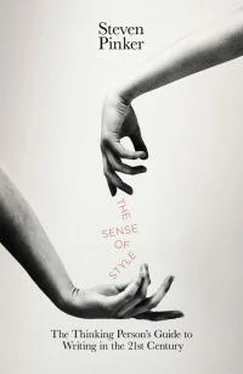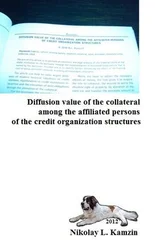Evidence is accumulating that most
of the
previous publications
that
claimed genetic associations with behavioral traits are false positives, or at best
are
vast overestimates of
the
true effect sizes.
Another tradeoff between brevity and clarity may be seen in the placement of modifiers. A noun can be modified either by a prepositional phrase on the right or by a naked noun on the left: data on manufacturing versus manufacturing data, strikes by teachers versus teacher strikes, stockholders in a company versus company stockholders . The little preposition can make a big difference. The headline MANUFACTURING DATA HELPS INVIGORATE WALL STREET could have used one, and a preposition would also have come in handy in TEACHER STRIKES IDLE KIDS and TEXTRON MAKES OFFER TO SCREW COMPANY STOCKHOLDERS.
Frequent strings and senses. Yet another lure into a garden path comes from the statistical patterns of the English language, in which certain words are likely to precede or follow others. 30As we become fluent readers we file away in memory tens of thousands of common word pairs, such as horse race, hunt ducks, cotton clothing, fat people, prime number, old man, and data point. These pairs pop out of the text at us, and when they belong to the same phrase they can lubricate the parsing process, allowing the words to be joined up quickly. But when they coincidentally find themselves rubbing shoulders despite belonging to different phrases, the reader will be derailed. That’s what makes the garden paths in the textbook examples so seductive, together with my real-word example that begins with the words The data point.
The textbook examples also stack the deck by taking advantage of a second way in which readers go with statistical patterns in the English language: when faced with an ambiguous word, readers favor the more frequent sense. The textbook garden paths trip up the reader because they contain ambiguous words in which the less frequent sense is the correct one: race in the transitive version of race the horse (rather than the intransitive the horse raced ) , fat as a noun rather than as an adjective, number as a verb rather than a noun, and so on. This can lead to garden paths in real life, too. Consider the sentence So there I stood, still as a glazed dog. I stumbled when I first read it, thinking that the writer continued to be a glazed dog (the frequent sense of still as an adverb), rather than that he was as motionless as a glazed dog (the infrequent sense of still as an adjective).
Structural parallelism. A bare syntactic tree, minus the words at the tips of its branches, lingers in memory for a few seconds after the words are gone, and during that time it is available as a template for the reader to use in parsing the next phrase. 31If the new phrase has the same structure as the preceding one, its words can be slotted into the waiting tree, and the reader will absorb it effortlessly. The pattern is called structural parallelism, and it is one of the oldest tricks in the book for elegant (and often stirring) prose:
He maketh me to lie down in green pastures; he leadeth me beside the still waters.
We shall fight on the beaches, we shall fight on the landing grounds, we shall fight in the fields and in the streets, we shall fight in the hills; we shall never surrender.
I have a dream that one day on the red hills of Georgia the sons of former slaves and the sons of former slave owners will be able to sit down together at the table of brotherhood. … I have a dream that my four little children will one day live in a nation where they will not be judged by the color of their skin but by the content of their character.
Structural parallelism works not just in poetic and hortatory passages but also in ordinary expository prose. Here is Bertrand Russell using it to explain the movement called romanticism:
The romantic movement is characterized, as a whole, by the substitution of aesthetic for utilitarian standards. The earth-worm is useful, but not beautiful; the tiger is beautiful, but not useful. Darwin (who was not a romantic) praised the earth-worm; Blake praised the tiger.
Go back to the four passages of good writing in chapter 1 and you’ll find example after example of structural parallelism, so many of them that after I called your attention to the first few I stopped pointing them out.
Although neophyte writers may repeat a simple sentence structure to the point of inanity, most writers go to the opposite extreme and vary their syntax capriciously. This can keep the reader off balance, luring her into wrong guesses about a sentence’s structure. Take this entry on noun plurals, from, of all books, The New York Times Manual of Style and Usage:
Nouns derived from foreign languages form plurals in different ways. Some use the original, foreign plurals: alumnae; alumni; data; media; phenomena . But form the plurals of others simply by adding s: curriculums; formulas; memorandums; stadiums .
Were you stopped short, as I was, by “form the plurals”? The passage begins with two indicative sentences whose subjects refer to foreign nouns, and whose predicates comment on how those nouns “form” or “use” the plural. Then, without warning, the third sentence shifts to the imperative mood and we are supposed to have the reader, not the nouns, forming plurals in a certain way.
And here’s an all-too-typical example from academic prose, where the author felt that he had to vary his syntax from clause to clause and ended up with a big fat garden path:
The authors propose that distinct selection pressures have influenced cognitive abilities and personality traits, and that intelligence differences are the result of mutation-selection balance, while balancing selection accounts for personality differences.
To be fair, it’s not the author’s fault that the technical term balancing selection looks like a verb phrase (to balance a selection) but is really a noun phrase (one of several kinds of natural selection). But to encourage the reader to parse it as a noun phrase, he should have set up a context in which the reader indeed expects to see a noun phrase. Instead he threw us off by ping-ponging from a cause-effect order in the first clause ( have influenced ) to an effect-cause order in the second ( are the result of ) and then back to a cause-effect order in the third ( accounts for ). And while he was at it, he varied his vocabulary from one sentence to the next, again for no good reason: cognitive abilities in the first clause refers to the same thing that intelligence does in the second. Recasting the sentence with parallel syntax and consistent terminology makes it intelligible even to readers who are not familiar with the technical terms:
The authors propose that distinct selection pressures have influenced cognitive abilities and personality traits: mutation-selection balance accounts for differences in cognitive ability, whereas balancing selection accounts for differences in personality traits.
Note, too, how parallel syntax can allow a reader to make sense of even the most unintelligible of the garden path sentences: Though the horse guided past the barn walked with ease, the horse raced past the barn fell.
Читать дальше












